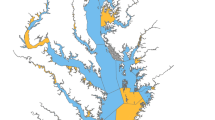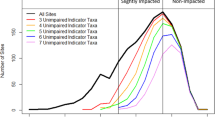Abstract
Most national standards for assessment of water quality include physical and chemical indicators relevant to specific pollutants and stressors. However, biological communities reflect not only current conditions of aquatic resources but also change in conditions over time and impacts from multiple stressors. Assessing the health of the aquatic community (that is, bioassessments) has proven to be critical in protecting and maintaining healthy surface waters under the mandates of regulatory frameworks, such as the Clean Water Act in the USA and the Water Framework Directive of the European Union. Whereas, in Thailand water standards, bioassessment is lacking in favor of chemical criteria, only coliform bacteria measurement can be considered a surrogate biological parameter. Our paper argues that incorporating bioassessment will improve water resource condition evaluations and recommends the use of the benthic macroinvertebrate assemblage as a bioassessment framework in Thailand. We discuss the implementation of a bioassessment program that consists of two major components, (a) a scientifically valid technical approach and (b) consideration of technical resources for a cost-effective program. The technical design comprises (1) classification of streams into similar groupings, (2) design of a biological survey, (3) a well-documented sampling protocol, (4) calibration of biological metrics for data analysis, (5) development of criteria for determination of ecological condition, and (6) communication of the results to citizens and policymakers. A cost-effective way to develop a bioassessment program that will improve Thailand’s ability to measure water quality and to make good decisions to attain healthy quality status is to establish partnerships by coordinating efforts and sharing data and technology with adjacent regional environmental offices or provinces. This collaboration would be fostered through a long-term national water resources management strategy and clear definition of goals and desired outcomes that are critical components of the overall National Plan for Ecological Health.
Similar content being viewed by others
References
Bailey, R. C., Norris, R. H., & Reynoldson, T. B. (2004). Bioassessment of freshwater ecosystem using the reference condition approach. Boston: Kluwer.
Barbour, M. T. (2008). The societal benefit of biological assessment and monitoring in rivers. In O. Moog, D. Hering, S. Sharma, I. Stubauer, & T. Korte (Eds.), ASSESS-HKH: Proceedings of the scientific conference “Rivers in the Hindu Kush–Himalaya—Ecology & Environmental Assessment” (pp. 5–7). Vienna: BOKU—University of Natural Resources and Applied Life Sciences.
Barbour, M. T., & Gerritsen, J. (1996). Subsampling of benthic samples: a defense of the fixed-count method. Journal of the North American Benthological Society, 15, 386–391. doi:10.2307/1467285.
Barbour, M. T., & Yoder, C. O. (2000). The multimetric approach to bioassessment as used in the United State of America. In J. F. Wright, D. W. Sutcliffe, & M. T. Furse (Eds.), Assessing the biological quality of freshwaters: RIVPACS and other techniques (pp. 281–292). Cumbria: Freshwater Biological Association.
Barbour, M. T., Gerritsen, J., Snyder, B. D., & Stribling, J. B. (1999). Rapid bioassessment protocols for use in streams and wadable rivers: Periphyton, benthic macroinvertebrates and fish (2nd ed.). EPA 841-B-99-002. Washington D.C.: U.S. Environmental Protection Agency.
Barbour, M. T., Poff, N. L., Norris, R. H., & Allan, J. D. (2008). Perspective: Communicating our science to influence policy. Journal of the North American Benthological Society, 27(3), 562–569. doi:10.1899/07-051.1.
Barbour, M. T., Swietlik, W. F., Jackson, S. K., Courtemanch, D. L., Davies, S. P., & Yoder, C. O. (2000). Measuring the attainment of biological integrity in the USA: A critical element of ecological integrity. Hydrobiologia, 422/423, 453–464. doi:10.1023/A:1017095003609.
Boonsoong, B. (2007). Rapid bioassessment for Thai streams with benthic macroinvertebrates. PhD thesis, Khon Kaen University, Thailand.
Boonsoong, B., Sangpradub, N., & Barbour, M. T. (2008). Development of rapid bioassessment approaches using benthic macroinvertebrates for Thai streams. Environmental Monitoring and Assessment. doi:10.1007/s10661-008-0423-2.
Clarke, R. T., Wright, J. F., & Furse, M. T. (2003). RIVPACS models for predicting the expected macroinvertebrate fauna and assessing the ecological quality of rivers. Ecological Modelling, 160, 219–233. doi:10.1016/S0304-3800(02)00255-7.
Davies, S., & Jackson, S. (2006). The biological condition gradient: A descriptive model for interpreting change in aquatic ecosystems. Ecological Applications, 16(4), 1251–1266. doi:10.1890/1051-0761(2006)016[1251:TBCGAD]2.0.CO;2.
Diamond, J. M., Barbour, M. T., & Stribling, J. B. (1996). Characterizing and comparing bioassessment approaches and their results: A perspective. Journal of the North American Benthological Society, 15, 713–727. doi:10.2307/1467818.
Karr, J. R., & Chu, E. W. (1999). Restoring life to running waters: Better biological monitoring. Washington, D.C.: Island.
Lathrop, J. E., & Markowitz, S. A. (1995). Monitoring water resource quality using volunteers. In W. S. Davis, & T. P. Simon (Eds.), Biological assessment and criteria: Tools for water resource planning and decision making (pp. 303–314). New York: Lewis.
Moog, O., & Chovanec, A. (2000). Assessing the ecological integrity of rivers: Walking the line among ecological, political and administrative interests. Hydrobiologia, 422/423, 99–109. doi:10.1023/A:1017053829050.
Morse, J. C., Bae, Y. J., Munkhjargal, G., Sangpradub, N., Tanida, K., Vshivkova, T. S., et al. (2007). Freshwater biomonitoring with macroinvertebrates in East Asia. Frontiers in Ecology and the Environment, 5(1), 33–42. doi:10.1890/1540-9295(2007)5[33:FBWMIE]2.0.CO;2.
Mustow, S. E. (2002). Biological monitoring of rivers in Thailand: Use and adaptation of the BMWP score. Hydrobiologia, 479, 191–229. doi:10.1023/A:1021055926316
Norris, R. H. (1995). Biological monitoring: The dilemma of data analysis. Journal of the North American Benthological Society, 14(3), 440–450. doi:10.2307/1467210.
Norris, R. H., & Barbour, M. T. (2009). Bioassessment of aquatic ecosystems. In G. E. Likens (Ed.), Encyclopedia of Inland waters (Vol. 3 pp. 21–28). Oxford: Elsevier.
Parnrong, S. (2002). A review of biological assessment of freshwater ecosystems in Thailand. Report submitted to Mekong River Commission.
Pollution Control Department (1997). Water quality criteria & standard in Thailand. Bangkok: Pollution Control Department, Ministry of Science Technology and Environment.
Resh, V. H. (1995). Freshwater benthic macroinvertebrates and rapid assessment procedures for water quality monitoring in developing and newly industrialized countries. In W. S. Davis, & T. P. Simon (Eds.), Biological assessment and criteria: Tools for water resource planning and decision making (pp. 167–177). New York: Lewis.
Resh, V. H. (2008). Which group is best? Attributes of different biological assemblages used in freshwater biomonitoring programs. Environmental Monitoring and Assessment, 138, 131–138. doi:10.1007/s10661-007-9749-4.
Resh, V. H., & Jackson, J. K. (1993). Rapid assessment approaches to biomonitoring using benthic macroinvertebrates. In D. M. Rosenberg, & V. H. Resh (Eds.), Freshwater biomonitoring and benthic macroinvertebrates (pp. 195–233). New York: Chapman and Hall.
Rosenberg, D. M., & Resh, V. H. (1993). Freshwater biomonitoring and benthic macroinvertebrates. New York: Chapman and Hall.
Sangpradub, N., & Boonsoong, B. (2006). Identification of freshwater invertebrates of the Mekong river and tributaries. Vientiane: Mekong River Commission.
Sangpradub, N., Inmuong, C., Hanjavanit, C., & Inmuong, U. (1998). A correlation study between freshwater benthic macroinvertebrate fauna and environmental quality factors in Nam Pong Basin. Research report submitted to Thailand Research Fund.
Savan, B., Morgan, A. J., & Gore, C. (2003). Volunteer environmental monitoring and the role of universities: The case of Citizens’ Environmental Watch. Environmental Management, 31, 561–568. doi:10.1007/s00267-002-2897-y.
Sethaputra, S., Thanopanuwat, S., Kumpa, L., & Pattanee, S. (2001). Thailand water vision: A case study. In L. H. Ti, & T. Facon (Eds.), From vision to action: A synthesis of experiences in Southeast Asia (pp. 71–98). Bangkok: The FAO–ESCAP Pilot Project on National Water Visions.
Stoddard, J. L., Larsen, D. P., Hawkins, C. P., Johnson, R. K., & Norris, R. H. (2006). Setting expectations for the ecological condition of running waters: The concept of reference condition. Ecological Applications, 16(4), 1267–1276. doi:10.1890/1051-0761(2006)016[1267:SEFTEC]2.0.CO;2.
Thorne, R. J., & Williams, W. P. (1997). The response of benthic macroinvertebrates to pollution in developing countries: A multimetric system of bioassessment. Freshwater Biology, 37, 671–686.
Author information
Authors and Affiliations
Corresponding author
Rights and permissions
About this article
Cite this article
Boonsoong, B., Sangpradub, N., Barbour, M.T. et al. An implementation plan for using biological indicators to improve assessment of water quality in Thailand. Environ Monit Assess 165, 205–215 (2010). https://doi.org/10.1007/s10661-009-0939-0
Received:
Accepted:
Published:
Issue Date:
DOI: https://doi.org/10.1007/s10661-009-0939-0




